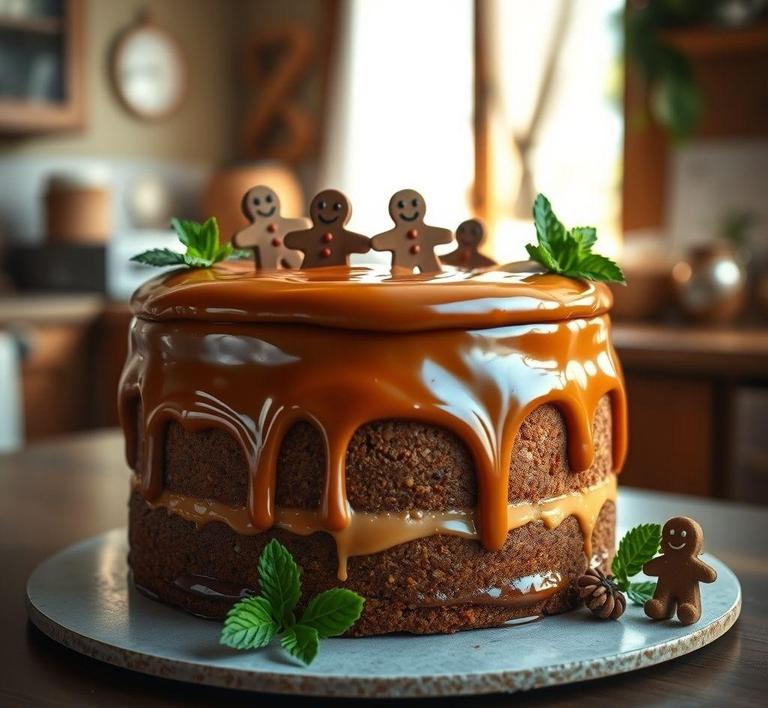Have you ever made a batch of delicious ginger cake and ended up with more than you could finish in one sitting? Well, don’t worry – you can easily refreeze ginger cake to enjoy it later! Refreezing ginger cake is a great way to preserve that warm, spiced flavor for another day. Whether you’ve baked a large batch or simply want to save some slices for the future, knowing how to properly refreeze your ginger cake ensures it stays fresh and tasty. In this guide, we’ll walk you through the best techniques and tips to refreeze ginger cake without sacrificing its mouthwatering texture or flavor.
Can You Refreeze Ginger Cake?

Yes, you can refreeze ginger cake, but with some important caveats. Like most baked goods, ginger cake is relatively forgiving due to its high sugar and fat content, which help preserve moisture and texture even after freezing. However, refreezing is not ideal as a regular practice. The more times a cake is frozen and thawed, the more its structural integrity, moisture content, and flavor profile are compromised.
The key factor is whether the cake has been thawed properly and stored safely. If the ginger cake was thawed in the refrigerator and has not sat out at room temperature for more than a couple of hours, it is generally safe to refreeze. However, if it was thawed on the counter, particularly in a warm kitchen, refreezing it poses a risk of bacterial growth, which could compromise food safety.
How To Refreeze Ginger Cake?
Refreezing ginger cake requires thoughtful handling to minimize quality loss. Here’s how to do it correctly:
- Cool and Assess: If the cake has already been thawed, ensure it hasn’t been left out at room temperature for long (ideally no more than 2 hours). If it’s been cut or partially consumed, check for any signs of spoilage-off smell, discoloration, or a slimy texture.
- Portion Wisely: Instead of refreezing the entire cake, consider cutting it into smaller portions. This allows you to thaw only what you need later, reducing the likelihood of repeated thawing and refreezing.
- Wrap Properly: Wrap each slice or piece tightly in plastic wrap or aluminum foil. To prevent freezer burn, add an outer layer of freezer-safe zip-top bags or airtight containers. Remove as much air as possible from the packaging.
- Label and Date: Always label the packaging with the refreezing date. This helps you track how long the cake has been in the freezer. For best quality, use refrozen ginger cake within 1-2 months.
- Freeze Quickly: Place the wrapped cake portions in the coldest part of the freezer. The faster they freeze, the better the texture will be preserved. If your freezer has a ‘quick freeze’ setting, use it.
Quality Impact
While ginger cake holds up better than many other baked goods due to its moist and dense texture, refreezing it inevitably leads to a noticeable decline in quality:
- Texture Degradation: Each freeze-thaw cycle encourages the formation of ice crystals, which can rupture the cake’s delicate crumb structure. The result? A drier, slightly rubbery texture upon reheating or serving.
- Flavor Dulling: Spices like ginger, cinnamon, and nutmeg tend to lose some of their punch after repeated freezing. This can make the cake taste a bit flatter or less vibrant than when freshly baked.
- Moisture Loss: Even with excellent wrapping, some moisture will be drawn out of the cake during freezing. This can leave the cake slightly crumbly or dry along the edges.
To help offset these impacts, consider serving refrozen ginger cake with accompaniments like a warm sauce (e.g., toffee, lemon glaze, or custard) or a dollop of whipped cream to add back moisture and richness.
While refreezing ginger cake is certainly possible and generally safe if done correctly, it’s not without trade-offs. Texture and flavor can suffer with each additional freeze-thaw cycle, so it’s best to plan ahead and freeze cake in single-use portions whenever possible. With proper wrapping and storage, a refrozen ginger cake can still make a delightful dessert-especially when enhanced with a touch of creativity in presentation or pairing. For optimal enjoyment, however, aim to freeze and thaw only once to preserve that soft, spice-laden richness that makes ginger cake so comforting and beloved.
Is It Safe To Refreeze Ginger Cake?
Refreezing ginger cake is generally safe-under the right conditions. The primary concern with refreezing any baked good, including ginger cake, revolves around both food safety and maintaining optimal texture and flavor. If the cake has been previously thawed in the refrigerator and kept at a safe temperature (below 40°F or 4°C) for no more than 2-3 days, it can typically be refrozen without posing a health risk.
However, each refreezing cycle gradually compromises the cake’s quality. Ginger cake, known for its rich, moist crumb and warm spice profile, is particularly sensitive to changes in moisture content. When it thaws, some of the moisture is released, and upon refreezing, this moisture forms ice crystals that can lead to a dryer, crumblier texture after the next thaw. Moreover, any glaze or frosting may separate, lose its sheen, or develop an unpleasant grainy consistency.
The key takeaway? Refreezing ginger cake is safe if done promptly and with attention to storage conditions, but it will likely impact taste and texture. It’s always best to freeze in single-use portions to avoid multiple freeze-thaw cycles.
Signs That Ginger Cake Should Not Be Refrozen
Before even thinking about popping that cake back into the freezer, inspect it closely. Refreezing is only advisable if the cake has remained within safe handling practices. Watch out for these red flags:
- Sour or Off Smell: Ginger cake naturally carries a fragrant, spicy aroma from ginger, cloves, and cinnamon. If the smell is sour, yeasty, or unpleasant, spoilage has likely begun.
- Mold Growth: Any visible mold-white, green, blue, or black fuzzy spots-means the cake is no longer safe to eat or refreeze. Even if it appears localized, mold roots can penetrate deeper into the cake.
- Slimy or Sticky Texture: A cake that feels unusually moist or sticky (outside of natural syrupy toppings or glaze) may be starting to ferment or spoil.
- Temperature Abuse: If the cake was thawed and left out at room temperature for over two hours, especially in warm environments, it has likely entered the bacterial ‘danger zone’ (40°F-140°F or 4°C-60°C) and should not be refrozen or consumed.
- Previously Refrozen Cake: Repeated refreezing can increase the risk of bacterial contamination, particularly if the thawed cake was exposed to fluctuating temperatures. It also significantly degrades the taste and structure, making it less enjoyable even if it’s safe.
Common Refreezing Mistakes
Many home bakers and cake lovers unintentionally mishandle refreezing, resulting in either food safety risks or disappointing dessert experiences. Here are the most frequent mistakes people make:
❌ Refreezing Room Temperature Cake: If ginger cake is thawed and then left out on the counter, it begins accumulating bacteria-even if it looks and smells fine. Freezing won’t kill these bacteria; it just pauses their growth.
❌ Not Using Airtight Wrapping: Freezer burn is real, and ginger cake is particularly prone to it due to its moisture content. Wrapping the cake loosely or not sealing it properly can result in dry edges, a frosty surface, and a freezer-flavored bite.
❌ Refreezing Frosted or Glazed Cake Improperly: Cream cheese frosting, lemon glazes, and butter-based icings often don’t survive freezing and thawing well. They may separate, curdle, or become gritty when refrozen without proper preparation.
❌ Thawing in a Warm Environment: Thawing the cake on a countertop or near a heat source may hasten bacterial growth, rendering it unsafe for refreezing even if it was only out for a short while.
❌ Refreezing Whole Cakes Repeatedly: If you freeze and thaw an entire ginger cake several times instead of slicing it into portions, you increase the likelihood of damaging the entire batch’s quality. The center of the cake also takes longer to freeze and thaw, potentially spending more time in unsafe temperature zones.
Tips and Tricks for Safely Refreezing Ginger Cake
If you must refreeze your ginger cake, here are a few best practices to help preserve its delightful texture, moist crumb, and bold spice:
✔ Portion Before Freezing: Slice your cake into individual servings before freezing. This reduces waste, avoids unnecessary thawing, and makes it easier to defrost only what you need.
✔ Wrap Tightly and Double Up: Use plastic wrap to seal each portion tightly, followed by a layer of aluminum foil or placement in a heavy-duty freezer bag. Squeeze out as much air as possible to prevent freezer burn.
✔ Use Freezer Labels: Clearly mark the date of freezing on each package. Aim to consume the cake within 1-2 months for best flavor and texture, although it may remain safe for up to 3 months.
✔ Defrost Gently: Always thaw ginger cake in the refrigerator, not on the countertop. This slower process keeps the cake at a safe temperature and helps maintain its integrity.
✔ Refresh Before Serving: After thawing, consider placing the cake slice in a preheated oven at 300°F (150°C) for 5-7 minutes. This can restore some of the softness and warmth, especially if the cake has become slightly dry.
✔ Avoid Refreezing Frosted Cakes: If your ginger cake has a cream-based or buttercream topping, scrape it off before freezing. Store the frosting separately (if possible) and reapply after thawing for a better texture.
Conclusion
While it is generally safe to refreeze ginger cake under controlled conditions, it’s a process that should be approached with care. Ensuring the cake hasn’t lingered in the danger zone, wrapping it well, and refreezing only once are critical to maintaining both safety and quality. Signs of spoilage-like off smells or visible mold-should immediately disqualify any thoughts of refreezing.
Ultimately, the best strategy is to plan ahead: freeze in portions, wrap with precision, and only defrost what you’ll use. With these tips in mind, you can enjoy the comforting spice and satisfying richness of ginger cake anytime-without compromising flavor, texture, or your health.


